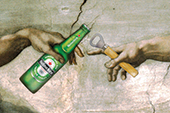How to Create Brand Engagement on Facebook
A recent study of 98 global brands identifies factors that increase — or decrease — the chances of consumers “liking,” commenting on or sharing a company’s Facebook posts.

Humorous posts, like this photo on Heineken’s Facebook page, receive many “likes.”
Over the last few years, brands have embraced Facebook Inc. as a key marketing channel to drive engagement and brand awareness. The question we asked was whether some brand content creates more brand engagement on Facebook than others. Looking for answers, we coded more than 1,000 wall posts from 98 global brands, hoping to gain a better understanding of how different wall-post attributes impact the number of “likes,” comments and “shares” a post receives.
From our research, we identified eight ways brand managers can increase the number of “likes” a post receives:
1. Express yourself through photos. Every picture tells a story. A photo is personal, and it can communicate quickly and easily. It also requires more thought and effort to take and include a photo in addition to text. To our surprise, what might be considered as blatant product promotion, in other words, putting up pictures of products from a company’s catalog, elicited a high number of “likes.”
2. Be topical. Keep up with the times. Messages considered topical are those referring to holidays, festivals, important events, etc. Topical messages may or may not contain a hint of the brand’s products. Even when they allude to the brand’s products, these messages are perceived to be more personable, rather than scripted promotions.
3. Don’t hesitate to be in your face. Promote the brand and its products. When consumers visit the brand’s wall, promotional messages are expected. We found that such messages also generate “likes.” Consumers visit the walls of brands they identify with and want to engage with.
4. Share the validation. Take a bow. Everyone wants to align themselves with a winner. By sharing success stories, achievements, awards and praise through wall posts, consumers can signal approval while also basking in the glory of a brand they identify with. By “liking” the post, fans indicate to their personal network their alignment with a successful brand. They are expressing their own positive self-identity through the brand’s achievements.
5. Educate the fans. Create informational value. Brands that generated or passed along information through wall posts also garnered a high number of “likes,” especially information designed for fans’ enrichment and education.
